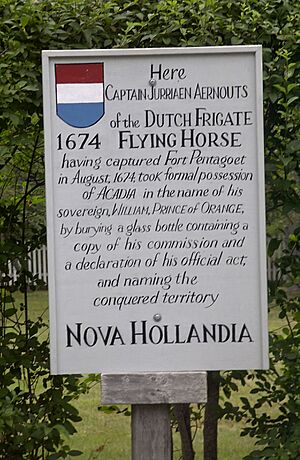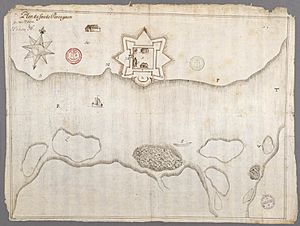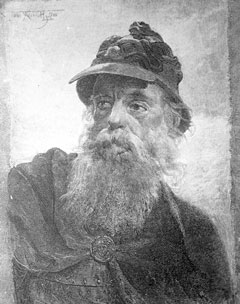Fort Pentagouet facts for kids
Fort Pentagouët was an important French fort built in what is now Castine, Maine. It was also known by other names like Fort Castine and Fort Saint-Pierre. For a short time (1670–1674), it was even the capital of Acadia, a French colony. This fort is considered the oldest permanent settlement in New England.
The fort was built in a great spot at the mouth of the Penobscot River. This area was perfect for trading valuable furs and timber. It was also a main route into the land, making it very important to European countries in the 1600s. The area, called Majabagaduce by the Abenaki people, changed hands many times. The French, Dutch, and England's Plymouth Colony all controlled it at different times.
Contents
Early French Settlement
In the winter of 1613, a French explorer named Claude de Saint-Étienne de la Tour started a small trading post here. He traded with the local Tarrantine Indians, who are now known as the Penobscots.
Soon after, in 1613, an English captain named Samuel Argall raided Mount Desert Island. This started a long argument about where the border was between French Acadia and the English colonies. La Tour quickly rebuilt his trading post to show the French were still there. In 1614, Captain John Smith explored the area and noted French traders were present. Later, in 1625, Charles de Saint-Étienne de la Tour built a stronger fort called Fort Pentagouët.
English Takeover
In 1629, English colonists from the Plymouth Colony took control of Fort Pentagouët. They used it as an outpost for their colony. Their governor, William Bradford, even traveled there himself to claim it.
French Control Under Aulnay
From 1635 to 1654, a French leader named Charles de Menou d'Aulnay de Charnisay managed the fort. In 1635, the French took it back, and it became part of Acadia again. Governor Isaac de Razilly sent Aulnay to recapture the area. In 1638, Aulnay built an even stronger fort, naming it Fort Saint-Pierre. Pentagouët was his most important outpost on the border with New England.
However, in 1653, Emmanuel Le Borgne and 100 men attacked the settlement. The next year, in 1654, Major General Robert Sedgwick led English volunteers and soldiers to attack Acadia. Before capturing the capital, Port Royal, Sedgwick took and looted Pentagouët. The English then held Acadia for 16 years, and Fort Pentagouët was not used much during this time.
Fort Pentagouët: Capital of Acadia
In 1670, Acadia was returned to the French. Fort Pentagouët then became the capital of Acadia. Two governors, Hector d'Andigné de Grandfontaine (1670–73) and Jacques de Chambly (1673-74), were in charge. A French officer named Saint-Castin had already set up his trading post nearby in 1667.

During the Franco-Dutch War in 1674, a Dutch captain named Jurriaen Aernoutsz arrived from New Amsterdam. He captured Pentagouët and other Acadian ports. The Dutch renamed Acadia to New Holland. After a second attack, the Dutch used the fort's own cannons to destroy most of its walls. Saint-Castin himself took it back in 1676. He renamed the town Bagaduce, a shorter version of Majabagaduce.
Saint-Castin's Influence
After the Treaty of Breda (1667) in 1667, Saint-Castin, who was once an officer at Fort Pentagoet, rebuilt French power nearby. He created a small trading post that grew into a new French and Indian community. French leaders sent Baron Jean-Vincent de Saint-Castin to take charge of Pentagouët.
The Baron married an Abenaki woman, who was the daughter of the chief Modockawando. She took the French name Mathilde and they had 10 children. After she passed away, he married another Abenaki woman, Marie Pidiwammiskwa, and they had two more children. Saint-Castin quickly became very important in colonial trade and in dealing with different groups. By 1677, his trading post was part of a village with 160 Etchemin Indians. It had two European buildings among thirty-two wigwams.
Conflicts and Raids

During King William's War, English Governor Sir Edmund Andros attacked and looted Saint-Castin's settlement in 1688. In response, Saint-Castin led a group of Abenaki warriors to raid the English settlement at Pemaquid (now Bristol, Maine) in August 1689. During this attack, the Maliseet people captured John Gyles. He later wrote one of the few stories about being held captive in Nova Scotia/Acadia. John Gyles' brother, James, was also captured and later killed at Fort Penobscot.
In 1692, the English attacked the village again. Major Benjamin Church destroyed the fort and stole from the settlement. After Baron de Saint-Castin and his sons returned to France, fewer people lived in the area.
Queen Anne's War
During Queen Anne's War, the French raided Deerfield in February 1704. In return, English Colonel Benjamin Church raided Saint-Castin's settlement (then called Penobscot). He then went on to raid other Acadian villages like St. Stephen, New Brunswick, Grand Pré, Pisiguit (now Windsor, Nova Scotia), and Chignecto. Saint-Castin's daughter was taken during this raid.
Images for kids







